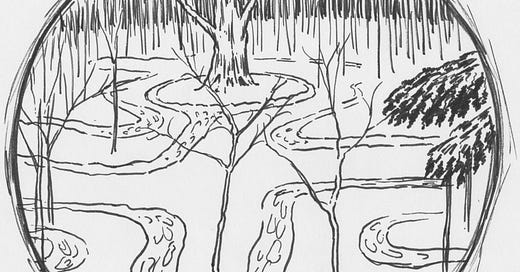In the early 1200s, some French monks laid paving stones in the form of an eleven-circuit labyrinth on the floor of the nave at Chartres Cathedral.
Eight hundred years later, during a particularly manic phase of my life, Wendy and I laid branches in the same pattern on the forest floor in the woods behind our house.
We decided to build our labyrinth on a small flat area that consisted primarily of beech saplings, 20-30 years old. My first job was to cut enough of them so we could eventually walk the labyrinth without having our eyes gouged out by twig-size branches. Remarkably—considering I usually went out equipped with nothing but a chainsaw and an abundance of nervous energy—I managed to cut just enough so the area still felt like woods as opposed to a “clearing”.
After using stakes and strings to lay out the eleven circuits, we began piling and intertwining branches and skinny saplings, pausing frequently to evaluate the aesthetics and practicalities of different path widths, placements, and dimensions—whether to go behind or in front of a still-standing sapling; how far down the small embankment we could go and still walk it comfortably; and, most importantly, the size and placement of the inner circle.
By the time we were done, the outer circle was more than 125 feet in diameter, almost four times larger than the one at Chartres. We weren’t trying to show off. In fact, we rarely showed it to anyone. Rather, even the most irreverent voices inside my head would admit that the labyrinth was probably already there…we just had to lay branches on top of it.
Intuitively, you’d think you build a labyrinth by making curving paths. Actually, you make the circles, as we did, figure out where the “cuts” are, and then round the branches from one border onto the adjacent one. Trust me, it makes sense.
So, having completed the circles, I went out one day in late December 2006, diagram and compass in hand, hammered stakes at the north, south, east, and west nodes, and made the cuts and curves. When Wendy came out to look at the end of the day, she felt something was off. She looked up at the sun. I looked down at my compass. We looked at each other. I had been making the cuts and curves based on magnetic north instead of true north.
The magnetic declination (magnetic north vs. true north) where we lived was -13o 42’. Since my energy field, at the time, was already seriously off-kilter, another 13o might not have made a whole lot of difference to me. But for Wendy and our friends, it could pose an invisible risk—like radon, black mold, and legislators who ban books.
So, the next day, at high noon, I marched with uncommon confidence out to the labyrinth, equipped with nothing but an old Boy Scout handbook, an old-fashioned watch with hands, and one brand new 12d finish nail. (The Boy Scouts use a toothpick, but that’s ‘cause, unlike me, they usually aren’t prepared with a 12d nail.) After I identified true north, Wendy came out to see if I’d earned my Merit Badge. She still looked at the north node rather suspiciously, but I held up my Boy Scout handbook, pointed at the shadow on the ground, and she yielded to superior wisdom. We re-made the appropriate breaks, rounded the corners, and had our labyrinth.
Building a labyrinth, however, is one thing. Walking it is something else altogether.
[To be cont’d.]





Hi David,
Thanks for sharing! It was timely for me to read and I just made a simple labyrinth on Centre Church's lawn when it was really cold a few weeks ago. We added ice candle holders and lit it for three nights. Maybe next year you can show me how to make a REAL one!:) I just made a path that worked it's way to a center point. Very pretty lit up at night:)
hey Dave give me a call, woody .917.885.8525